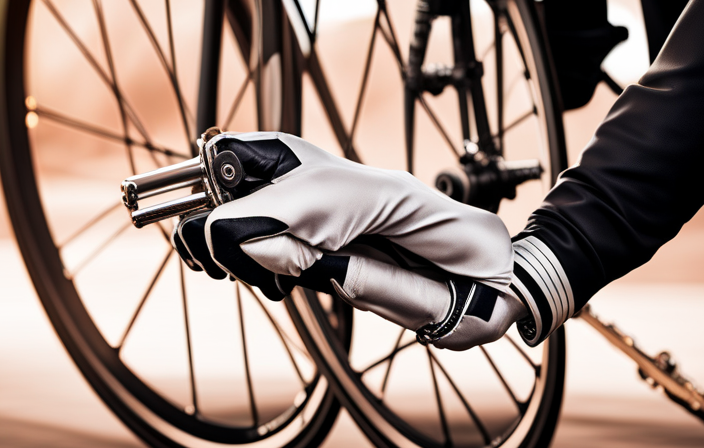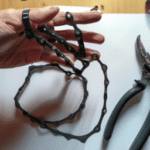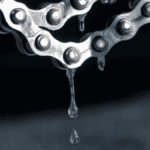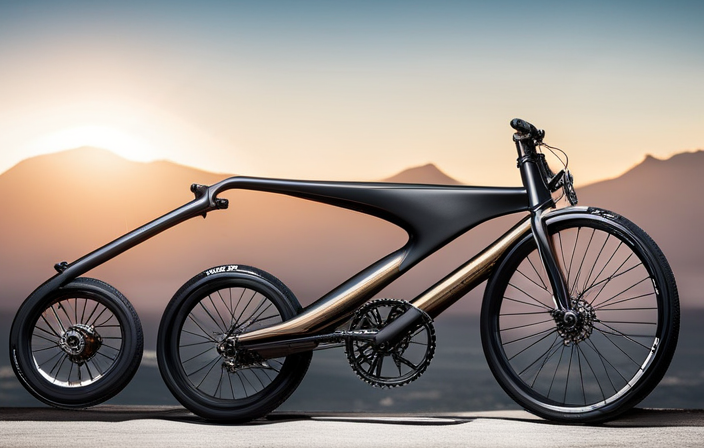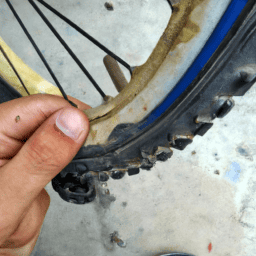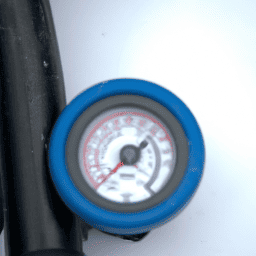Picture the exasperation of a tangled and twisted bike chain, leaving your favorite two-wheeler unable to move. Have no worries, as I am here to assist you in unraveling this mechanical conundrum.
With the right tools and a little elbow grease, you’ll have that chain working smoothly again in no time.
In this article, I will provide you with step-by-step instructions on how to tackle this challenge, ensuring that your bicycle is ready for your next adventure.
So, let’s dive in and unravel the mysteries of the tangled chain.
Key Takeaways
- Gather the necessary tools and set up a clean and spacious work area.
- Assess the severity of the tangle and determine if the chain needs to be removed from the bike.
- Use a lubricant to loosen knots and gently manipulate the chain to untangle it.
- Be patient, take your time, and use lubricant to free stuck links without causing further damage.
Gather the necessary tools
Gather the necessary tools to untangle a bicycle chain. Bike maintenance is important to ensure a smooth and safe ride. When it comes to chain maintenance, having the right tools is essential.
You will need a chain tool, which is used to remove and reinstall the chain links. This tool allows you to break the chain apart and put it back together once it is untangled. Additionally, you will need a pair of needle-nose pliers to help manipulate the chain and a rag to clean off any dirt or grime. Having these tools on hand will make the process much easier and efficient.
Now, let’s find a clean and spacious area to work on untangling the bicycle chain.
Find a clean and spacious area to work
Look for a well-lit and open space where you can comfortably work on it. Here are a few tips for organizing your bike repair space:
- Clear any clutter and ensure you have enough room to move around freely.
- Set up a sturdy workbench or table to hold your tools and bike parts.
- Keep all your tools within reach by using a pegboard or tool organizer.
Once you’ve found the perfect spot, it’s time to clean and maintain your bike chain properly. Start by wiping off any dirt or debris using a clean rag. Then, apply a degreaser to remove any built-up grime. Use a brush or toothbrush to scrub the chain thoroughly. After cleaning, make sure to lubricate the chain with a high-quality bike chain oil.
Now that you have your workspace ready and your chain cleaned, it’s time to assess the severity of the tangle and determine the next steps.
Assess the severity of the tangle
Check how tangled your bike chain is by gently pulling on it and observing how freely it moves. Assessing the severity of the tangle is crucial in determining the best approach to untangling it.
If the chain moves smoothly and there are only a few minor knots, you may be able to untangle it without removing it from the bike. However, if the chain is tightly knotted or twisted, it may be necessary to remove it for easier manipulation.
Troubleshooting common chain tangle causes can help you understand why the chain became tangled in the first place. This includes examining the chain for any signs of damage or debris, such as dirt or grease buildup.
By understanding the severity of the tangle and identifying its root cause, you can effectively proceed to the next step of removing the chain from the bike if necessary.
Remove the chain from the bike if necessary
If the chain is too tangled, you may need to take it off the bike to make it easier to fix. Removing the chain is a simple process that requires a few tools and some basic knowledge of bike maintenance. First, locate the quick link or master link on the chain. This is a special link that can be easily disconnected, allowing you to remove the chain from the bike. Use a chain tool or a pair of pliers to disconnect the quick link. Once the quick link is removed, the chain can be easily pulled off the bike. Remember to be careful and gentle when handling the chain to avoid causing further damage. With the chain removed, you can now proceed to the next step of using a lubricant to loosen the knots and untangle the chain.
By removing the chain from the bike, it becomes much easier to fix any tangles or knots that may be causing issues. This step is particularly useful when the chain is severely tangled and cannot be untangled while still on the bike. Taking the chain off allows for better access and visibility, making it easier to identify and resolve any problems. Additionally, removing the chain provides an opportunity to clean and lubricate it, which is an important part of regular bike maintenance. Proper lubrication helps to prevent future tangles and ensures smooth operation of the chain. With the chain removed and any necessary repairs made, it can then be reinstalled onto the bike.
Use a lubricant to loosen the knots
Using a lubricant will help to loosen the knots in the chain. Here are the steps to follow:
-
Apply a chain lubricant: Use a chain lubricant specifically designed for bicycles. This will ensure smooth operation and prevent further damage to the chain.
-
Allow the lubricant to penetrate: Give the lubricant some time to work its magic. Let it penetrate the knots and loosen them up. This will make the untangling process much easier.
-
Gently manipulate the chain: Once the lubricant has had enough time to work, gently manipulate the chain with your hands. Move it back and forth to help loosen any remaining knots.
-
Wipe off excess lubricant: After you’ve successfully untangled the chain, wipe off any excess lubricant. This will prevent dirt and debris from sticking to the chain.
Now that the chain is lubricated and the knots are loosened, we can move on to the next step of starting to untangle from the outside of the chain.
Start untangling from the outside of the chain
To begin untangling, start from the outermost part of the chain.
When dealing with a tangled bicycle chain, it’s important to approach the task with the right techniques. Tangles can occur due to various reasons, such as improper storage or riding over rough terrain.
By starting from the outside, you can gradually work your way towards the center, avoiding further entanglement. Gently hold the chain with one hand while using your other hand to carefully separate any twisted links.
Take your time and be patient, as rushing could lead to more knots. As you navigate through the chain, it’s helpful to use a lubricant to loosen any stubborn areas.
Once you have successfully untangled the chain, you can move on to the next step of gently pulling and wiggling the chain to free any stuck links.
Gently pull and wiggle the chain to free any stuck links
Once you’ve successfully separated the twisted links, gently pull and wiggle the chain to release any links that may be stuck. This pulling technique is crucial in untangling the chain effectively.
Here are three reasons why this technique is essential:
- It allows you to feel the resistance and identify any stubborn links that need extra attention, ensuring a thorough untangling process.
- The gentle pulling and wiggling motion gradually loosens the chain, preventing further entanglement and minimizing the risk of damage.
- By applying consistent and controlled force, you can gradually free the stuck links without causing unnecessary strain on the chain or surrounding components.
Moreover, the effectiveness of using a lubricant cannot be overstated. A lubricant reduces friction between the links, making the untangling process smoother and easier.
Now, to further untangle tight knots, we can use a thin object, like a toothpick or needle, to carefully navigate through the chain and separate any tightly entangled sections.
Use a thin object, like a toothpick or needle, to carefully untangle tight knots
To carefully navigate through the chain and separate any tightly entangled sections, you can gently insert a toothpick or needle. This thin object will allow you to carefully untangle the chain without causing any further damage. As you insert the toothpick or needle, be sure to move it in a back and forth motion to loosen any knots. If you don’t have a toothpick or needle on hand, you can also try using a small paperclip or a thin piece of wire as an alternative. Additionally, it may be helpful to apply some alternative lubricants, such as WD-40 or cooking oil, to the tangled areas to help loosen them up. Remember, patience is key during this process. Take breaks and be patient as you work through the tangled chain, ensuring a successful untangling process.
Take breaks and be patient
Remember to take breaks and be patient as you work through the tangled chain.
Untangling a bicycle chain can be a tedious process, and it’s important not to rush. Trying to force the chain apart or untangling it too quickly can lead to further knots and frustration.
Instead, take your time and approach each knot with a calm and steady hand. If you start to feel frustrated, step away for a moment and clear your mind. Sometimes, a fresh perspective can make all the difference.
Once you’ve successfully untangled the chain, it’s time to move on to the next step: using a chain cleaner or degreaser to remove any dirt or grime. This will ensure that your chain runs smoothly and efficiently.
Use a chain cleaner or degreaser to remove any dirt or grime
Using a chain cleaner or degreaser is necessary to eliminate any accumulated dirt or grime. Here are some discussion ideas about the benefits of using a chain cleaner or degreaser for regular chain maintenance:
Improved performance: A clean chain reduces friction and allows for smoother pedaling, resulting in enhanced efficiency and a more enjoyable ride.
Extended chain lifespan: Regular cleaning prevents dirt and grime from building up and causing premature chain wear, prolonging its lifespan.
Easy maintenance: Using a chain cleaner or degreaser simplifies the cleaning process, saving time and effort.
Protects other components: A clean chain prevents dirt and grime from spreading to other parts of the bike, protecting them from unnecessary damage.
When choosing the right chain cleaner or degreaser, consider factors such as compatibility with your chain type and environmental friendliness. Once the chain is clean, it’s important to rinse and dry it thoroughly to prepare for the next step.
Rinse and dry the chain thoroughly
After using a chain cleaner or degreaser to remove any dirt or grime from the bicycle chain, it is crucial to rinse and dry the chain thoroughly. This step ensures that all the cleaning solution and residue are completely removed from the chain.
I recommend using a hose or a bucket of water to rinse the chain, making sure to focus on each link to ensure no debris is left behind. Once rinsed, it is important to dry the chain thoroughly using a clean cloth or towel, making sure to remove any excess moisture.
Once dry, it is time to apply a lubricant to the chain to prevent future friction and reduce the likelihood of knots forming.
Now, let’s move on to inspecting the chain for any damage or weak points.
Inspect the chain for any damage or weak points
First, take a close look at your chain to inspect for any signs of damage or weak points. To properly assess its condition, use the following inspecting technique:
-
Examine the chain links: Look for any visible cracks, bends, or missing pieces. These could indicate potential weak points that may lead to chain failure.
-
Check for rust or corrosion: Rust can weaken the chain and affect its performance. Look for any reddish-brown spots or rough patches on the metal surface.
-
Measure chain wear: Use a chain wear indicator tool or ruler to measure the elongation of the chain. Excessive wear can cause poor shifting and reduce overall efficiency.
-
Listen for unusual sounds: Rotate the chain while listening for any clicking, grinding, or squeaking noises. These may suggest misalignment or damaged components.
By following these chain maintenance tips and inspecting your chain thoroughly, you can ensure its longevity and optimal performance.
Now, let’s move on to the next step and apply lubricant to the chain to ensure smooth operation.
Apply lubricant to the chain to ensure smooth operation
To ensure smooth operation, make sure you apply lubricant to your chain regularly. Proper lubrication is essential for maintaining the longevity and efficiency of your bicycle chain.
When applying lubricant, it’s important to follow the correct techniques. Start by cleaning the chain thoroughly with a degreaser to remove any dirt or old lubricant. Once the chain is clean, apply the lubricant evenly, making sure to cover all the links. Allow the lubricant to penetrate the chain for a few minutes before wiping off any excess.
Regular chain maintenance not only ensures a smoother and quieter ride, but it also helps prevent rust and corrosion. By keeping your chain well-lubricated, you can extend its lifespan and improve your overall cycling experience.
Now, let’s move on to the next step of reinstalling the chain onto the bike.
Reinstall the chain onto the bike
Once you have applied lubricant to the chain, you can proceed to reinstall it onto your bike. To ensure a smooth and hassle-free process, here are some reinstalling tips to keep in mind:
-
Proper alignment: Align the chain with the chainrings and cassette, ensuring it sits correctly in the front and rear derailleur.
-
Tension adjustment: Check the chain tension by pulling it upwards at the midpoint. It should have a slight amount of give, about half an inch.
-
Quick link installation: If your chain has a quick link, make sure it is properly installed and locked into place.
-
Troubleshooting common issues: If you encounter any difficulties while reinstalling the chain, check for twisted links, bent derailleur hangers, or misaligned gears.
With these tips in mind, you can successfully reinstall your bike chain.
Now, let’s move on to testing the chain’s functionality and making any necessary adjustments.
Test the chain’s functionality and make any necessary adjustments
After reinstalling the chain, it’s important to test its functionality and make any necessary adjustments. To ensure proper performance, start by assessing chain tension.
Gently push the chain up and down at the midpoint between the front and rear sprockets. The ideal tension is when the chain moves up and down about half an inch. If it’s too loose, it may come off during riding, and if it’s too tight, it can cause excessive wear on the chain and sprockets.
Next, check for chain wear. Inspect the chain for any signs of stretching or damage, such as rust or stiff links. If you notice excessive wear, it’s best to replace the chain to prevent further damage to the drivetrain.
Making these necessary adjustments will ensure a smooth and efficient ride.
Frequently Asked Questions
What tools do I need to untangle a bicycle chain?
To untangle a bicycle chain, you’ll need a few simple tools: a chain breaker tool, pliers, and a rag. Common mistakes when untangling a chain include forcing it and not properly cleaning it. Tips for preventing future chain tangles include regular cleaning and lubrication.
Is it necessary to remove the chain from the bike to untangle it?
No, it is not necessary to remove the chain from the bike to untangle it. Proper techniques include using a chain tool, lubricating the chain, and gently manipulating it. Common mistakes to avoid include forcing the chain or using excessive force.
How do I assess the severity of the tangle?
To assess the severity of a tangle in a bicycle chain, I inspect the degree of twisting, knotting, and tightness. Then, I use the best techniques for untangling a chain, such as carefully manipulating the links or using a chain tool.
Can I use any lubricant to loosen the knots?
I wouldn’t recommend using WD-40 or any other lubricant to loosen the knots in a bicycle chain. It’s best to manually untangle the chain using your hands or a chain tool for better control and to avoid damaging the chain.
What should I do if I notice any damage or weak points in the chain while untangling it?
If I notice any damage or weak points in the chain while untangling it, I should carefully inspect it for any bent or broken links. If necessary, I can repair damaged chains or replace them to prevent future chain tangles.
Conclusion
After diligently working through the steps to untangle a bicycle chain, the feeling of accomplishment is undeniable.
As I look down at the now smooth and well-lubricated chain, I can almost hear the gentle hum of the bike gliding effortlessly along the road.
The satisfaction of a job well done fills me with a sense of pride and confidence.
With this newfound knowledge and skill, I am ready to tackle any future chain mishaps that may come my way.
So, grab your tools and get ready to conquer those tangled chains like a pro!

